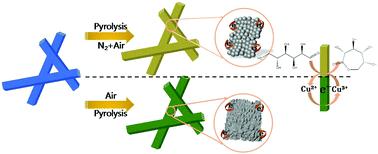当前位置:
X-MOL 学术
›
Inorg. Chem. Front.
›
论文详情
Our official English website, www.x-mol.net, welcomes your
feedback! (Note: you will need to create a separate account there.)
Tunable hierarchical surfaces of CuO derived from metal–organic frameworks for non-enzymatic glucose sensing
Inorganic Chemistry Frontiers ( IF 6.1 ) Pub Date : 2020-02-24 , DOI: 10.1039/d0qi00104j Yumei Luo 1, 2, 3, 4, 5 , Qingyong Wang 6, 7, 8, 9, 10 , Jinghua Li 1, 2, 3, 4 , Fen Xu 1, 2, 3, 4 , Lixian Sun 1, 2, 3, 4, 5 , Yiting Bu 1, 2, 3, 4 , Yongjin Zou 1, 2, 3, 4 , Heinz-Bernhard Kraatz 11, 12, 13, 14 , Federico Rosei 14, 15, 16, 17
Inorganic Chemistry Frontiers ( IF 6.1 ) Pub Date : 2020-02-24 , DOI: 10.1039/d0qi00104j Yumei Luo 1, 2, 3, 4, 5 , Qingyong Wang 6, 7, 8, 9, 10 , Jinghua Li 1, 2, 3, 4 , Fen Xu 1, 2, 3, 4 , Lixian Sun 1, 2, 3, 4, 5 , Yiting Bu 1, 2, 3, 4 , Yongjin Zou 1, 2, 3, 4 , Heinz-Bernhard Kraatz 11, 12, 13, 14 , Federico Rosei 14, 15, 16, 17
Affiliation

|
Non-enzyme glucose sensors constructed using transition metal oxides present several advantages such as their low cost, high stability, and high sensitivity. Herein, a kind of porous nanosphere-stacking CuO structure has been synthesized by optimizing the thermal decomposition atmosphere, which was derived from Cu-metal–organic framework (Cu-MOF) microrods. Such hierarchical CuO structures, with controllable porosity and adjustable surface area, are efficient catalytic materials for glucose sensing. Benefiting from structural advantages, the obtained porous hierarchical CuO nanospheres exhibit enhanced sensing performance compared to hierarchical CuO clusters. Based on CuO, the effects of surface and morphology on the sensing performance of glucose are also discussed. The sensitivity of CuO porous hierarchically nanospheres for glucose is found to be 1806.1 μA cm−2 mM−1 in the wide linear range of 0–6.535 mM with a low detection limit (S/N = 3) of 0.15 μM. Glucose detection in artificial saliva is then performed, which shows excellent capability in the low concentration range (5 μM–1.165 mM) for non-invasive sensing performance. The sensor also demonstrates a good recovery in real saliva. The novel MOF-templated CuO hierarchical nanospheres are expected to be effective sensing materials for developing non-enzyme and non-invasive glucose sensors.
中文翻译:

源自金属-有机框架的CuO的可分级层次表面,用于非酶葡萄糖传感
使用过渡金属氧化物构造的非酶葡萄糖传感器具有许多优点,例如它们的低成本,高稳定性和高灵敏度。在此,通过优化热分解气氛,合成了一种多孔纳米球堆叠的CuO结构,该结构源自Cu-金属-有机骨架(Cu-MOF)微棒。具有可控制的孔隙率和可调节的表面积的这种分层的CuO结构是用于葡萄糖感测的有效催化材料。受益于结构优势,与分层CuO团簇相比,获得的多孔分层CuO纳米球表现出增强的感测性能。基于CuO,还讨论了表面和形态对葡萄糖传感性能的影响。−2 mM -1在0–6.535 mM的宽线性范围内,低检测限(S / N = 3)为0.15μM。然后进行了人工唾液中的葡萄糖检测,显示了在低浓度范围(5 μM–1.165 mM)中非侵入式传感性能的出色能力。该传感器还显示出真实唾液的良好恢复。新型MOF模板化的CuO分层纳米球有望成为开发非酶和非侵入性葡萄糖传感器的有效传感材料。
更新日期:2020-02-24
中文翻译:

源自金属-有机框架的CuO的可分级层次表面,用于非酶葡萄糖传感
使用过渡金属氧化物构造的非酶葡萄糖传感器具有许多优点,例如它们的低成本,高稳定性和高灵敏度。在此,通过优化热分解气氛,合成了一种多孔纳米球堆叠的CuO结构,该结构源自Cu-金属-有机骨架(Cu-MOF)微棒。具有可控制的孔隙率和可调节的表面积的这种分层的CuO结构是用于葡萄糖感测的有效催化材料。受益于结构优势,与分层CuO团簇相比,获得的多孔分层CuO纳米球表现出增强的感测性能。基于CuO,还讨论了表面和形态对葡萄糖传感性能的影响。−2 mM -1在0–6.535 mM的宽线性范围内,低检测限(S / N = 3)为0.15μM。然后进行了人工唾液中的葡萄糖检测,显示了在低浓度范围(5 μM–1.165 mM)中非侵入式传感性能的出色能力。该传感器还显示出真实唾液的良好恢复。新型MOF模板化的CuO分层纳米球有望成为开发非酶和非侵入性葡萄糖传感器的有效传感材料。











































 京公网安备 11010802027423号
京公网安备 11010802027423号